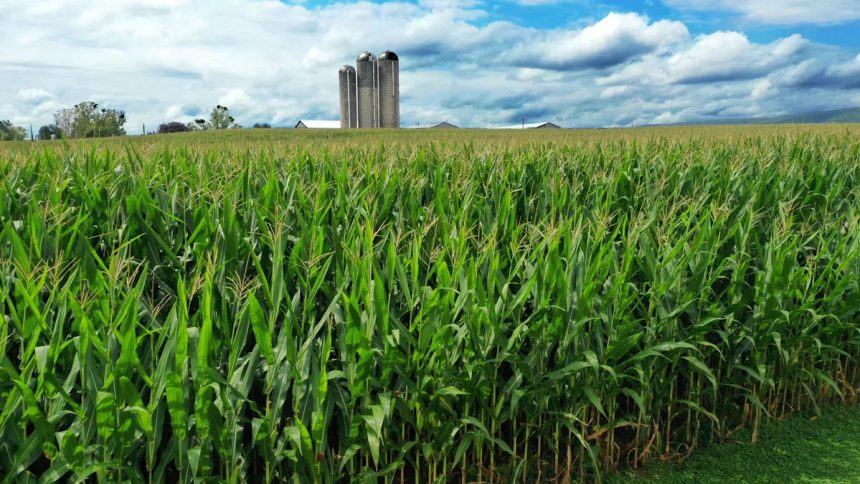Farmers across the country are looking at record yields during their fall harvest. They may have nowhere to sell them.
As a result of President Donald Trump’s trade war with China, crop farmers have lost a significant export market, driving down the price of top U.S. crops like soybeans and corn, even as Trump’s tariffs drive up the cost of farm equipment and fertilizer.
Now, as they approach the end of growing season, those farmers, farm groups and Republican lawmakers from agriculture-heavy states are warning of a looming crisis: crops piling up with nowhere to put them and farmers ending the year deep in the red.
They’re still not ready to blame Trump and his trade policies, however, a sign of just how much grace the agriculture community continues to grant Trump, even as his ambitious efforts to restructure the global trade economy clash directly with their economic interests. This fall could prove the stiffest loyalty test yet, as the administration struggles to make progress in trade negotiations it’s promised will finally bring the ag industry some relief.
“When our members are in the fields harvesting, they will be staring at a visual representation of this economy and this looming farm crisis. They will be looking at literal piles of corn and other row crops,” said Lesly Weber McNitt, vice president of public policy at the National Corn Growers Association. “They don’t know where it’s going.”
Farmer sentiment dropped in June, July and August, according to Purdue University’s Ag Economy Barometer, a monthly survey that measures the health of the agricultural economy, but it’s still higher than when former President Joe Biden was in office.
“I think the farmers realize, particularly crop producers, this is not going to be a good year by any stretch of the imagination,” said Michael Langemeier, the director of Purdue’s Center for Commercial Agriculture. “But when you ask things about the long-term policy environment, they’re always positive related to those questions.”
That faith in the Trump administration’s long-term policy objectives hinges, in large part, on the administration’s promises to ink new trade agreements with other countries that could pave the way for more sales of U.S. agricultural goods abroad.
Rep. Mark Alford (R-Mo.), who represents a mix of suburban and rural areas between Kansas City and Jefferson City, acknowledged in an interview that farmers in his district “are hurting.”
“They’re going to have one of the biggest corn crops in history, but the input prices are so high, and the commodity prices are so low, that a lot of farmers are just kind of hanging on,” Alford added.
But Alford, who had a contentious back-and-forth with a farmer over tariffs at an August town hall, has continued to defend Trump’s trade policies as a way to pressure other countries to open up their markets — particularly China, the largest foreign purchaser of U.S. soybeans over the past decade and a major buyer of other American ag products, as well.
“China is the linchpin in all of this,” Alford said. “And I’m trusting that President Trump is going to strike a deal that is going to equalize our trade with China and also restore some of the imports they’ve had for our grains, our beans and our meat.”
Other farm state Republicans are toeing a similar line.
Kansas Sen. Jerry Moran said farmers “see this effort by the president to work tariffs in a way that’s to their favor.” But Moran also had a warning: “The need for those issues to be resolved is quick. It’s soon.”
Trump’s trade negotiations, however, aren’t poised to offer any immediate breakthroughs to ease farmers’ pain. The talks with China have proceeded particularly slowly, with the president last month granting another extension for negotiations — to Nov. 12. The U.S. legal battle over Trump’s tariffs, which is likely to be decided by the Supreme Court in the coming months, gives the Chinese government even more incentive to slow-walk the talks.
As it stands now, Washington and Beijing are frozen in a low-grade trade war, with double-digit tariffs on each other’s exports. While not as high as the 100-plus percent duties the two sides briefly imposed in May, the tariffs, coming on top of levies imposed during Trump’s first term, have forced both countries to look for other sources of key goods.
In 2024, for example, China purchased $12.64 billion in soybeans. But China has not yet made any orders for soybeans since May, according to the American Soybean Association, as it shifts more purchases to Brazil and other countries.
Corn growers, meanwhile, appear hurt by their own success. Record yields are driving the price of corn down, and they haven’t been able to secure new export markets. Corn sales to China rose sharply in 2021 and 2022, making it the country’s top export market at the time, as it attempted to fulfill its promise to purchase an additional $200 billion in U.S. agricultural product as part of a trade agreement in Trump’s first term.
But those purchases fell sharply in 2023 and 2024.
Even as the Trump administration has promised to rejuvenate agriculture exports to China, it’s pointing to preliminary trade agreements with other partners it says will open up alternative ag markets.
“As we have seen deal after deal after deal hit the world stage, with more announcements coming in the next few weeks, even more exciting deals, [sinking farmer] sentiment, we believe, will turn from unease with the current farm economy,” Agriculture Secretary Brooke Rollins told Fox Business Network on Thursday.
In July, Trump shook hands on agreements with the European Union, Japan and South Korea, as well as smaller countries like Indonesia and the Philippines, all of which have agricultural components. Japan, for example, pledged to purchase $8 billion in agricultural goods from the U.S. per year (although that is less than the $14.3 billion in agricultural purchases it averaged between 2020 and 2024, according to data collected by the Agriculture Department).
They still haven’t come close to making up for the loss of the massive Chinese market.
Combined, Japan and the European Union purchased $3.4 billion worth of soybeans in 2024 — a quarter of the $12 billion China purchased. And while both trading partners purchased more corn than China in 2024, the combined amount was still smaller than what China was able to purchase in its 2022 peak.
Japan, for example, pledged to purchase $8 billion in agricultural goods from the U.S. per year, which is less than the $14.3 billion in agricultural purchases it averaged between 2020 and 2024, according to data collected by the USDA.
Hopes that the administration would be able to open major new markets, like India, have also failed to come to fruition. Instead, the administration slapped a 50 percent tariff on the world’s fourth-largest economy last month, souring the relationship and pushing New Delhi closer to China.
In Trump’s first term, the White House paid out $28 billion in financial relief for farmers hurt by his trade policies. Officials at the Agriculture Department have privately started to prepare for a similar bailout fund for this term but are unlikely to roll out any tariff relief payments this fall, according to three people with direct knowledge who were granted anonymity to discuss the private plans. That’s also around when lawmakers will be looking at replenishing USDA’s pot of money designated for emergency situations, Deputy Secretary Stephen Vaden has told reporters.
In a written statement, a USDA spokesperson said the administration is working to provide assistance to farmers and pinned the blame on the Biden administration, saying it squandered a strong farm economy.
“Secretary Rollins is working to reorient the department to be more effective at serving the American people and put farmers first,” the statement said. “Fortunately, President Trump is taking strong action to support farmers by executing new trade deals and quickly rolling out programs like the Emergency Commodity Assistance Program that provides $10 billion in direct assistance to producers.”
But that $10 billion came from a short-term spending bill passed in December and was a patchwork attempt to help farmers amid stalled negotiations on the massive legislative package known as the farm bill. Republicans also cut into Supplemental Nutrition Assistance Program funding in order to give farmers a $60 billion boost in the One Big Beautiful Bill Act, but that won’t take effect until the next crop year.
“I’ve not seen any evidence that there’s any proposal coming from the administration for direct financial aid,” Moran said. “Farmers have always told me, and I think they believe it, that they want markets, not payments. And we need markets.”
That need is about to become a lot more tangible, as farmers start to harvest their crops and top out their grain storage.
“We, as a government, should be recognizing that and trying every way we can to do the next trade deal … because what is going to happen, sure as I’m sitting here, is corn will be stacked in the streets,” said Sen. Jim Justice (R-W.Va.). “Truly, I don’t know how we’re going to stop it.”
Meredith Lee Hill contributed to this report.









